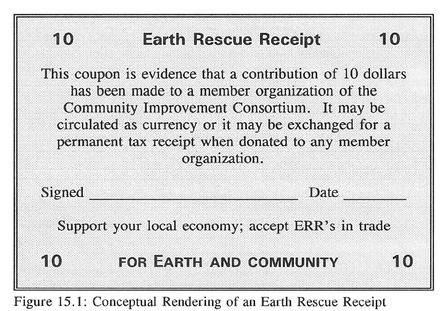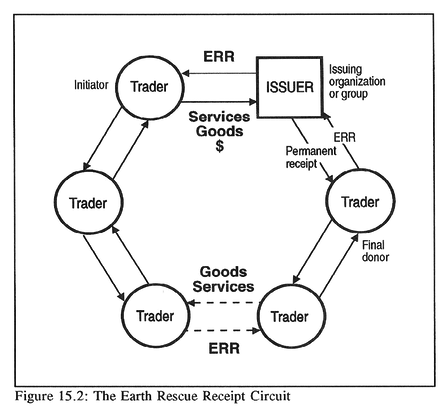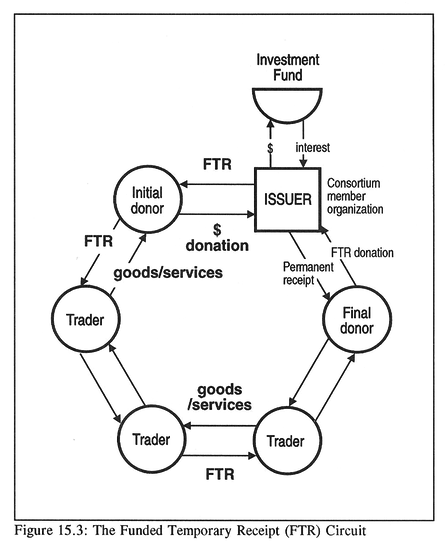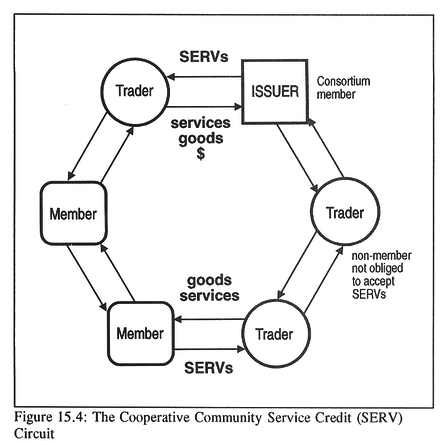"Our objective should be to create exchange media issued on the basis of human service and Earth service rather than acquisitiveness and domination."
-- Greco
In addressing the mega-crisis which confronts the world today, it should be clear that decisive changes will need to be made in the methods we humans use to distribute power and allocate material resources. As pointed out earlier, the present dominant structures of money and finance, by their very nature, promote the concentration of power into fewer and fewer hands, increase the disparity in the distribution of wealth, channel the vast majority of the earth's resources into wasteful production, and force both social and ecological degradation. The pinnacle of power today is the power to issue money. If that power can be democratized and focused in a direction which gives social and ecological concerns top priority, then there may yet be hope for saving the world.
This chapter describes three proposals for achieving that. These proposals have two primary features: (1) the use of local currencies to facilitate trade and (2) the empowerment of groups which are working to serve the common good. Although they are described in terms of circulating certificates or notes, these exchange media could also take the form of credits in a mutual credit system or some combination of account credits and circulating notes.
The basis of issue of money has, in times past, been more neutral than at present. Now, with the issuance of money controlled by the central government/central bank nexus, it has become a mechanism by which these elements control the application of human and capital resources and allocate them to projects which are usually self-serving, wasteful of resources, and often downright destructive. Our objective should be to create exchange media issued on the basis of human service and Earth service rather than acquisitiveness and domination.
The exchange media described below put control of the exchange process into the hands of the people, giving them more choice over how they will apply their energies and resources. The willingness of others in the community to accept the new exchange media in payment for goods and services, especially the necessities of life, does two things -- it encourages the application of people's energies and resources to life-sustaining activities, and it provides the community with a medium of exchange that by its very nature is abundant, democratic, and locally controlled.
Earth Rescue Receipts (ERR's)
Earth Rescue Receipts (ERR's) are paper receipts for contributions made to what we will call "good work" organizations. ERR's would be issued by any organization which is a member of a consortium of mutual aid, social action, community improvement, environmental and other such organizations. These receipts, issued in small denominations, would simply acknowledge the donation of money, materials, equipment or services to a member organization. They would provide evidence that the donor has done "good work." Unlike the usual receipt form used to acknowledge a donation or payment, ERR's would be printed in standardized denominations, say $5, $10, $20, and $50, and would bear the name and seal of the consortium. When a donor makes a donation, the receipt would be dated and signed and/or validated by the recipient organization and given to the donor. Such a receipt might look like the one shown in Figure 15.1.

|
Except for the standard denominations, the steps described above are much the same as current practice. So what are the key features of the ERR proposal which make it empowering? Well, what if the donor, who now holds the ERR, were able to get something of value for it? Suppose some local businesses were to agree to accept ERR's in trade? In that case, ERR's could become a circulating currency. The original donor would not be any poorer for having made the donation, but would simply have "gotten the ball rolling." An ERR would be considered to be a "temporary receipt" (TR) which could be spent. Thus, ERR's would pass from hand to hand, enabling any number of trades.
Anyone wishing to make a permanent donation would take ERR's to any organization which is a consortium member and exchange them for a "permanent receipt" (PR) which s/he would hold for tax purposes. [100] This is the means by which ERR's would be extinguished and go out of circulation. If at any point in time there were an excess of ERR's in circulation (as evidenced by discounting or refusal of ERR's in the marketplace), the consortium would suspend further issuance until permanent donations caught up with temporary donations and reduced the amount of ERR's in circulation to the proper level. Figure 15.2 is a pictorial illustration which shows the process of issuance, circulation, and redemption of Earth Rescue Receipts.

|
As the positive effects of this process become more evident, more and more people will want to share the burden of community improvement, either by making additional donations to the member organizations, or by accepting ERR's in trade and in the payment of debts. Growing acceptance of this exchange medium, and the increasing local prosperity which it brings, will encourage greater and greater amounts to be contributed to the "good work" organizations and encourage work which is in the public interest. As the use of ERR's expands and proliferates, this process could largely replace taxation as a means of supporting the common good. Besides providing a local medium of exchange, it would provide a more participatory process for local community finance, eliminating the need for many government expenditures and transfer payments.
- Questions and Answers:
- Q. Why would anyone accept Earth Rescue Receipts instead of official
currency?
A. ERR's will be acceptable for three reasons: ERR's will appeal, first to those who support the activities which give rise to their issuance; secondly, to those who can see the benefits which a local currency provides in strengthening the local economy; and thirdly to those who can see that they represent a sound medium of exchange which is spendable in the community. - Q. What will make ERR's a sound medium of exchange?
A. ERR's are not issued arbitrarily. They are issued on the basis of actual contributions of value to a participating organization. Each ERR, therefore, represents a receipt for actual value delivered, either in cash, materials, labor or services. The amount of ERR's issued can never exceed the amount of value delivered. An ERR will circulate only until some holder decides to contribute it back to an issuing organization. At that point a permanent receipt will be issued to the donor, to be held for tax purposes, and the ERR will be retired from circulation until a new donation makes it possible to reissue it. - Q. Suppose not enough ERR's are donated back to member organizations,
won't the amount in circulation keep building up and cause
inflation? [101]
A. That's an excellent question and it gets to the heart of the monetary problem. The issuance of ERR's, or any other currency which people are free to discount or refuse, can never cause inflation. Here's why. First of all, one must understand what inflation is. Inflation is an increase in the general level of prices expressed in terms of the predominant currency unit - in the present case, Federal Reserve "dollars." In the past, the unit of account which we use, the dollar, was defined as a particular weight of gold. Paper notes were issued to represent gold dollars and were convertible, on demand of the holder, into gold, at the bank. When paper notes or bank credits are improperly issued into circulation, the value of all such notes is diluted; people will then prefer to hold gold instead of paper. If they accept paper at all, it will be at a discount, i.e. they might accept paper dollar notes but ask a higher price in paper dollars than in gold dollars.When money is an object of political control, as it has become in every country of the world, the issuing authorities will attempt to prevent the discounting of their notes and the loss of their gold reserves by redemption. They will refuse to convert the paper currency into gold and declare the notes to be "legal tender." The effect of these measures is to obliterate the value standard and force acceptance of the inferior paper currency. When this happens, sellers have no way of protecting themselves from harm except by raising prices. Without a forced acceptance of the currency, there can be no inflation. Thus, inflation, which consists of higher prices generally, is really a symptom that the market is devaluing the official currency. Since traders are required by law to accept it at face value, the only adjustment they can make is to raise their prices.
So the answer to your question is that, since ERR's need not be accepted at face value, an excess of ERR's in circulation will cause them to be discounted or refused by sellers in the market. If people see this happening, they will tend to ease off on making initial donations of goods and services because the ERR's they would receive could not be spent for full value. At the other end of the line, permanent donors who can make use of the tax deduction will tend to accept more ERR's to donate for tax purposes since they can acquire ERR's more cheaply. For example, if a one dollar ERR is being accepted in the market at only 90 cents, a permanent donor could obtain a $1 tax deduction at a cost of only 90 cents. Whenever the market is free to discount the value of a note (accept it at less than face value), this fact makes that currency system self-adjusting.
So to sum up, what can happen with an alternative currency is that it might not be accepted at par with the unit of account or official currency. In the past, discounting of private currencies below par has occurred. Such discounting is the result of improper issuance. In the case of Earth Rescue Receipts, the amount issued is strictly determined by the amount of value already donated, which itself is a measure of the community's willingness to support the activities of the issuing organizations.
The deciding factor on the amount which will remain in circulation is the time period within which the receipts will be deemed to be valid in trade. This could be six months, a year, or forever. If an expiration date is specified, an ERR would no longer be accepted in trade after that date, but the holder could still exchange it for a permanent receipt and obtain the associated tax deduction. The experience of the market should make the determination as to whether or not an expiration date should be used.
- Q. How will counterfeiting be avoided?
A. Effective anti-counterfeiting measures have been well developed over a period of many years. These are commonly employed by governments and issuing banks to protect their currencies. They involve close security over the printing process, special inks and papers, serial numbering, and other measures. There is no reason why these same measures cannot be utilized for local currencies. Beyond that, there are two additional factors which will discourage counterfeiting of a local currency. The limited area within which they are accepted and limited time period within which they would be circulated as a payment medium tend to make counterfeiting unprofitable.
Funded Temporary Receipts (FTR's)
While a local currency system such as the Earth Rescue Receipts described above might approach more closely the ideals for monetary transformation set forth previously, a funded local currency might be initially more acceptable and less vulnerable to official interference. It would probably provide better tax advantages to donors under current IRS regulations. It would be similar in many ways to the Earth Rescue Receipts and could work as follows:
- A consortium of non-profit, social action and community improvement groups
could begin a program under which a trustee would accept, on behalf of its
members as a group, deposits of official money from any benefactor.
- These deposits would constitute an endowment fund which would be invested
in ways which would provide income in official currency to help the
organizations meet their cash needs. It might be wise to invest these funds
only in direct obligations of the U.S. Treasury, i.e. government bills, notes
and bonds. [102] Alternatively, the funds might be invested in securities of
quasi-governmental agencies such as the Government National Mortgage
Association (GNMA) and Federal Farm Credit Bank, which might use them in more
socially responsible ways.
- These deposits would be non-refundable to the depositor; instead, the
consortium would issue to the depositor "funded temporary receipts" (FTR's)
in standard small denominations, say $5, $10, $20, and $50. FTR's would bear
the name and seal of the consortium.
- These FTR's would be spendable with any business or individual willing to
accept them.
- FTR's would thus circulate as currency.
- Any individual wishing to make a permanent contribution to any member
organization of the consortium could do so by delivering FTR's to that
organization.
- The organization would then issue to the donor a permanent receipt (PR)
for tax purposes, allowing the donor to receive a tax deduction for his/her
contribution.
- Such contributions would certainly be tax-deductible because they
represent the final action in conveying to the recipient organization
entitlement to the deposit of official money. [103]
- Only recipient organizations which are members of the "good work"
consortium would be allowed to redeem the temporary receipts for official
currency (draw official money out of the endowment pool), and only to a
limited extent, preserving most or all of the principal and allowing only the
income to be spent. [104]
- Interest earned on the Treasury investments would accrue to the
consortium and be credited to the members' accounts in proportion to the
amount in "funded temporary receipts" donated to each organization in the
given period. Thus, the organizations which are most strongly supported by
the community will receive the greater portion of the investment earnings, as
well.
- Organizations which are consortium members need not use the temporary receipts (FTR's) which they receive as donations to draw official money out of the pool, but instead may choose to spend them back into circulation, using them to pay employees and suppliers. Likewise, any interest income credited to its account, instead of being withdrawn in dollar currency, could be left on deposit and used as the basis for spending an equivalent amount of FTR's into circulation. Figure 15.3 is a pictorial illustration of the process.

|
- Questions and Answers:
- Q. What's the point of this project?
A. There are several beneficial results which can be expected from the implementation of this project. The main objective though is to shift the bulk of human effort away from conspicuous consumption, waste and the production of war materiel, toward "good work" which addresses human needs and the needs of the planet.
- Q. How does this plan achieve that?
A. First, by encouraging the support of organizations which are taking action toward positive change, and secondly, by partially substituting a democratic, locally-controlled, asset-based exchange medium in place of the official monopolized, centrally-controlled, debt-based exchange medium.
- Q. Well, how does that work?
A. It encourages the support of "good work" organizations by reason of the fact that the original depositor need not necessarily be the ultimate donor, but s/he may be able to spend the FTR's which s/he receives in return for making a deposit. The process of donation is begun when the deposit is made and temporary receipts (FTR's) issued, but completed only when the FTR's are delivered by the ultimate donor back to some participating organization. Thus, anyone with a dollar can "get the ball rolling" without making any financial sacrifice at all, except to forego the potential interest income on the money deposited. But if a donor is relatively poor and needs to spend the money instead of investing it anyway, this represents no loss to him/her. Yet, it does result in a gain for the consortium group. In effect, the official currency becomes a capital pool earning income for the "good work" organizations; even the poor are empowered to be philanthropic; and the community is provided with a democratic, locally controlled, life-supporting medium of exchange.
This approach could ultimately transform the entire official money supply into an endowment fund for good work. Further, it allows the supporters of good work, as a group, to maximize their collective tax advantage. Those who can make the best use of the tax deduction will be the ones who make the ultimate donations (of FTR's).
In the existing system of money and finance, money is first allocated to those enterprises which promise the greatest monetary return, or to those mandated by the existing power structure -- mega-corporations, government bureaucracies, military establishments, land and corporate speculators. Under the proposed system, the allocation priorities are reversed. It puts positive change and public service groups first instead of last in the allocation of funds, and empowers the realization of popular values, not just those of the rich and powerful. It may help to fulfill the prediction that "...(the) first shall be last, and the last first." [105]
- Q. Can other organizations join the consortium after it is initially
formed?
A. Yes. Any organization wishing to participate may be admitted to the consortium by agreeing to the terms of membership.
- Q. What if an organization is philosophically opposed to those already in
it?
A. In the spirit of conviviality, no non-profit organization should be excluded. Nor are exclusionary qualifications necessary because an organization can directly benefit only to the extent that people make donations of FTR's to it. Thus, membership in the consortium in itself does not provide any direct financial benefit to an organization; it benefits only to the extent that it has popular support and receives donations of FTR's.
Cooperative Community Service Credits
A Cooperative Community Service Credit system provides another way of
mobilizing resources to serve community needs. It too is similar to the
Earth Rescue Receipt, but focuses more specifically on volunteer services and
specific projects. There is always a limit to the amount of time and energy
which volunteers can afford to donate. A service credit system attempts to
transcend the limitations of reliance upon volunteer service by acknowledging
the value of services rendered, without the payment of scarce money, but by
issuing service credit receipts. Businesses, as well as individuals, in the
community could be encouraged to accept service credits in partial or full
payment for the goods and services they offer for sale. The issuing
organization(s), then, would accept the receipts from others either as
donations or in payment for some of the services it provides.
Let's consider a possible example. Let's call the value unit in this system a "SERV." A SERV would be equivalent to one dollar's worth of service. A group of social action, community, environmental, self-help, and mutual-aid organizations might agree to jointly publish a periodical for education and outreach. All work would be paid in service credit receipts (SERVS) redeemable by the publication for copy space in the publication, advertising, and other related services, such as typesetting, layout, mailing list management, etc. The more space a member organization wants in the magazine, the more service credit receipts it must deliver to the consortium. It can get them as donations, or earn them by doing work on the publication, or by selling some of its services. Figure 15.4 shows the creation and circulation of Cooperative Community Service Credits.

|
Businesses can earn SERVS by accepting them in trade, either from the individuals who have earned them by working on the publication, or from other businesses which have accepted them in payment. The businesses can then donate the receipts to any member organization, or use them to pay for advertising in the publication. Businesses, by accepting the receipts in partial payment for their goods and services, would stimulate their own business just as the use of a discount coupon does, but unlike a discount coupon, service credit receipts can be passed along (spent) for value, or donated to promote activities of benefit to the community. Such a system might be started by making an announcement like the following.
ANNOUNCEMENT
YOUR CHANCE TO SUPPORT
A HEALTHY COMMUNITY
AND A CLEAN ENVIRONMENT
ANNOUNCING PUBLICATION OF THE COMMUNITY WEEKLY
All of our workers are paid for their work in "service credits," or "SERVS." You can support them and our publication by accepting our service credit receipts as you would your own discount coupons, for, say 20%, 30%, 50%, or more, off your regular prices. But, unlike discount coupons, service credit receipts can be used by you to buy things you need. You yourself can spend SERVS for goods and services offered by other participating businesses, or you can use them to buy valuable advertising in our magazine, COMMUNITY WEEKLY. You can also use SERVS to pay for our typesetting, design, and layout services. We can do your advertising flyers, menus, business cards, or forms. Or, you might prefer to donate SERVS to any of our member organizations which you might wish to support.Call today and let us add you to our list of participating businesses. We will periodically publish this list in our magazine, indicating for each business, the percentage of payment which it accepts in SERVS. The higher the percentage, the more business you'll attract. And remember, it costs you nothing, because you, in turn, can spend the SERVS you accept. By accepting COMMUNITY WEEKLY service credits, you'll be helping the magazine to improve the community and you'll be boosting your own business. EVERYBODY WINS!
Each business would sign an agreement form such as the one below:
___(Name of business)___ agrees to accept ___(Name of consortium/publication)___ service credit receipts (SERVS) in partial payment for all products and services which it offers, to the extent of _____% of the purchase price. ___(Name of consortium/publication)__ agrees to accept its own service credit receipts at face value in payment for advertising or other services which it customarily offers, to the extent of _____% of its standard fees.This agreement may be canceled by either party at any time upon written notice.
Signed__________________________ Date________
Signed__________________________ Date________